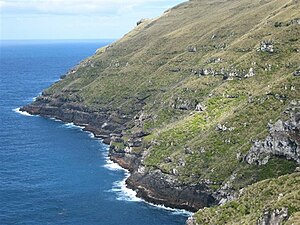Auckland Island
| Auckland Island | ||
|---|---|---|
| The interior of Auckland Island | ||
| Waters | South pacific | |
| Archipelago | Auckland Islands | |
| Geographical location | 50 ° 43 ′ S , 166 ° 6 ′ E | |
|
|
||
| length | 42 km | |
| width | 20 km | |
| surface | 458.89 km² | |
| Highest elevation |
Cavern Peak 650 m |
|
| Residents | uninhabited | |
| main place | Hardwicke (historical) | |
| Cape Lovitt , the westernmost point of New Zealand | ||
Auckland Island ( māori : Motu Maha ) is the largest island in the New Zealand archipelago of the Auckland Islands , officially known as the Auckland Islands . As the main island , it bears the same name as the archipelago, which was named by Captain Abraham Bristow when it was discovered in1806in honor of William Eden, Lord Auckland's 1st Baron Auckland . It is also the largest uninhabited island outside the polar regions.
geography
Auckland Island is located about 465 km south of New Zealand's South Island in the southern Pacific Ocean . With 458.89 km² it is by far the largest island in the archipelago . The island has a length of 40 km in its north-south extension and measures around 12 km at its widest point.
The highly rugged and mountainous island is characterized by steep cliffs of basalt on the West Coast, which can rise up to 365 m, and numerous fjords and bays on the east coast. The highest point at 659 m can be found with Cavern Peak roughly in the middle of the island. The westernmost point of Auckland Island , Cape Lovitt , is also the westernmost point of New Zealand. The historic settlement of Hardwicke is located on Port Ross , a fjord in the northeast of the island . It was the center of a settlement attempt by British immigrants in 1850, which was abandoned after only 2 years and 9 months. To the south of Auckland Island , separated by the Carnley Harbor strait , lies Adams Island , to the northeast of it is Enderby Island , the third largest island in the archipelago. The fourth largest island, Disappointment Island , is just 4 km to the west.
Flora and fauna
Is known Auckland Iceland for a feral domestic pig breed of animals, the Auckland Iceland Pigs . They were brought to the island by the first whale and seal hunters in 1807, feral and lived largely undisturbed on the island for around a hundred years. Since they caused severe damage to the indigenous flora and fauna, the New Zealand Department of Conservation decided to remove them in 1999 . Only 17 pigs survived and were moved to mainland New Zealand to preserve the breed. Because of the large number of introduced species, the endemic bird species of the Auckland Islands, such as the Auckland duck ( Anas aucklandica ), no longer occur on the main island. The protected bays in the east of the island are home to the South Island ironwood ( Metrosideros umbellata ), which forms the southernmost forests in New Zealand here.
Web links
- Auckland Islands . Department of Conservation,accessed July 30, 2012.
- Topomap - Auckland Islands - 1: 50,000 . (JPG) Land Information New Zealand ,accessed July 30, 2012.
- Murihiku expeditions . Paul Hulford, Auckland,accessed July 31, 2012.
Individual evidence
- ↑ Auckland Islands . Department of Conservation , accessed July 30, 2012 .
- ↑ [1] , largest.org, accessed January 20, 2020.
- ↑ a b Map of the Auckland Islands . Department of Conservation , accessed August 25, 2019 .
- ↑ Auckland Island Pigs - A Rare Breed of New Zealand Origin . Rare Breeds Conservation Society of New Zealand Incorporated , accessed July 31, 2012 .



